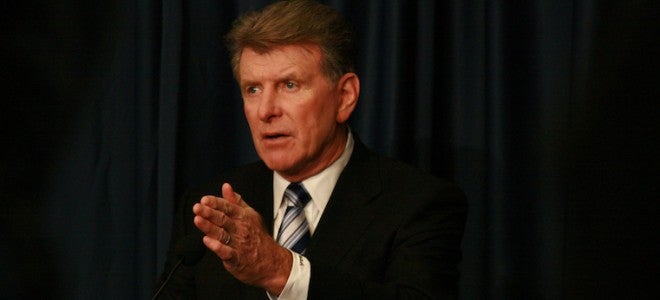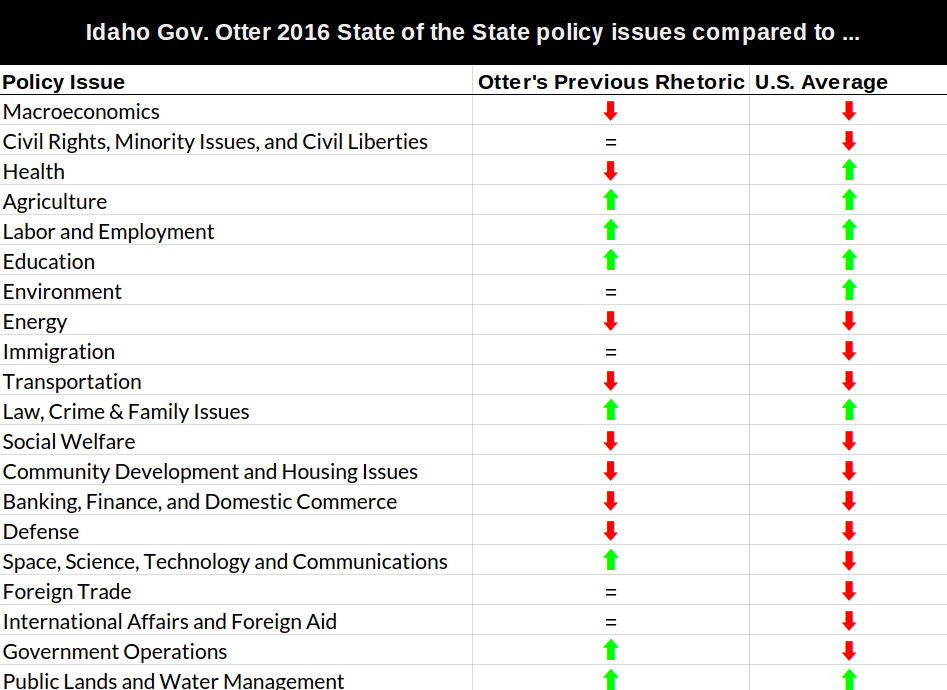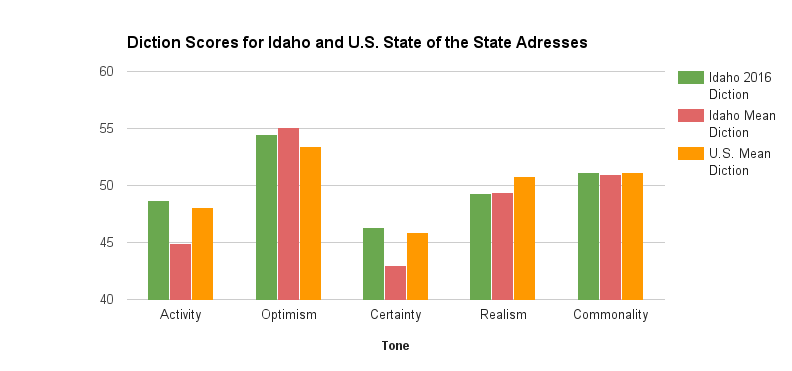

Justin S. Vaughn is an associate professor of political science in the School of Public Service and director of the Center of Idaho History and Politics at Boise State University. His research focuses on American politics, with an emphasis in executive politics, political rhetoric and communication, and the linkage between public policy and public opinion. He earned his Ph.D. at Texas A&M University, and his B.S. and M.S. at Illinois State University.

Tyler Holden is working on an MA in political science at Boise State.
State of the State textual analysis yields insight into vigor of upcoming legislative session
“The State of Idaho is healthy and strong,” stated Idaho Governor C. L. “Butch” Otter on Monday January 11, as he delivered his annual State of the State address to legislators and other assorted dignitaries. Like his fellow governors across the nation, Otter used the occasion to set his agenda for the legislative session to come.
The form and substance of these addresses vary widely across the nation. In Idaho the speech serves a particularly pragmatic purpose. In essence, it is the opening salvo in the interbranch negotiations between legislative and executive branch that will take place over the next few months. In the speech, Governor Otter identified the depth and breadth of his policy priorities.
For decades, scholars have been developing and improving a way to study policy agendas. Arguably the leading effort in this area is known as the Policy Agendas Project, a massive project currently housed at the University of Texas that seeks to understand the dynamics over time of policy activities across several governing arenas. To do so, the leaders of that effort have developed a coding scheme that identifies nearly two dozen distinct major policy areas, including health, agriculture, education, immigration, social welfare and more.
Although this coding scheme can be applied to many different policy activities, such as a congressional hearing or an executive order, scholars have recently made headway in applying the Policy Agendas Project’s model to policy rhetoric. By coding what are called “quasi-sentences” (or self-contained statements, typically identified by a semicolon or period), scholars can tell you not only what percentage of a speech was policy focused, but also which issue areas a politician talked about and which they did not. “Finally, it is my sincere wish that we undertake our work together in this legislative session without keeping one eye on the upcoming election. Instead, let us proceed with a focused commitment to applying government’s proper role to our current challenges and to improving the lives of generations to come.” – Otter 2016 State of the State
Applying this approach to Governor Otter’s recent speech, we learn a good deal about his priorities going into the 2016 legislative session. First, there is an added emphasis on policy. Nearly a quarter of the statements the governor made had a policy focus. This might not seem like a lot, but consider that is about 14 percent more than his average State of the State address between 2009-2015, and about 17 percent more than the national average over that same time span.

Also noteworthy is where Governor Otter’s policy priorities appear to be focused. For example, his attention to economic matters was just below both state and national average, but his focus on education dwarfed those averages, nearly doubling the focus seen nationally over the past several years.
Though not as much of a focus in his speech as education, Otter’s focus on law, crime and family issues was also higher than state and national averages. He was at or slightly above average on several other issues, including health, agriculture, labor and employment, the environment and science and technology policy. In fact, only on a few issues — energy, transportation, social welfare, banking/finance/commerce — was his policy focus slightly below national average. Taken together, evidence suggests Governor Otter might have plans for a robust legislative session.
Speeches such as the State of the State are not just about substance, however. They are also about tone. By analyzing the key tonal dimensions of the text of a speech, we can learn more than just what issues a leader wants to emphasize and how much of the budget they prefer to commit to which initiatives. We can also learn about that leader’s core civic values, especially in how they compare with their peers.
By using a textual analysis program known as DICTION, we are able to identify the tone of any text across five key dimensions: activity, optimism, certainty, realism, and commonality. Each dimension tells us something unique about the speech and, ostensibly, the speaker. For example, ”activity” indicates the energy behind a speech, its focus on accomplishing new things, while ”commonality” emphasizes those aspects that unite the audience. Certainty, realism, and optimism are more self-explanatory dimensions, which are discussed in greater detail in this article published in The Blue Review in 2014.
By analyzing the text of Governor Otter’s 2016 State of the State address and comparing it to the average scores of both Idaho and other American governors over the past several years, we see that his performance on some dimensions is quite consistent with prior trends. For instance, his commonality score in this year’s speech is consistent with both Idaho and national averages (2009-2015 for both categories). On realism, Otter’s speech is on par with Idaho trends — in this case, a comparison with his own tone in past State of the State speeches — and only very slightly below the national average.

On other dimensions, Governor Otter’s speech is noteworthy. His resoluteness, indicated by his certainty score, is higher than the national average and nearly 10 percent higher than in his average State of the State. Conversely, the governor’s optimism score this year is slightly lower than his average, but higher than the national average. With respect to activity, Otter’s 2016 rhetoric is consistent with national trends, but about 8 percent higher than the previous Idaho average.
What can we take away from these figures? Compared to recent history (essentially his prior State of the State speeches), Governor Otter is more intent on significant policy action this session, especially concerning education policy, even if he may be marginally less optimistic than usual. Whether this energetic resoluteness is a function of 2016 being an election year or perhaps because the years left in his third and final gubernatorial term are dwindling is unknown, but savvy watchers of the current legislative session should not be surprised if a great deal is accomplished by the time the legislature gavels out of session later this spring.